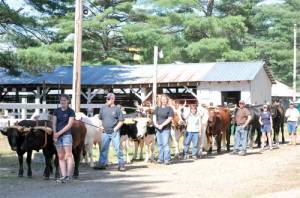Oxen demo at Back to Past recalls proud heritage
By Gail Geraghty
Staff Writer

THAT’S SOME CATTLE POWER — It’s not often anyone gets to see eight head-to-tail teams of oxen hooked together and hauling logs, but that’s what’s in store for those who attend this year’s “Back to the Past†at Scribner’s Mill, set for Saturday and Sunday, Aug. 6 and 7. The teams will practice hauling together in a line and navigating around obstacles, and will offer ox cart rides, on Saturday, from 10 a.m. to 4 p.m. — in preparation for a special four-day exhibition this November at Kentucky Horse Park in Lexington, Ky.
HARRISON — No celebration of “Back to the Past†at Scribner’s Mill would be complete without the presence of oxen.
It was teams of oxen, hitched to log carts with wooden wheels that powered the mill just as surely as water from the Crooked River powered the paddle wheels. It was oxen, with their great strength and endurance that were first used to pull the granite into place to build the dam and the mill foundation. It was oxen that hauled the heavy equipment and lumber used to build the mill in 1846.
And this year at “Back to the Pastâ€, set for Saturday and Sunday, Aug. 6 and 7, eight teams of oxen will take center stage, as they demonstrate the pivotal role played by working steer in early New England agriculture and industry.
“We’ve never done anything like this before,†said Dottie Bell of Waterford, who raises Scottish Highland Cattle with her husband David at Thunder Hill Farm.
Oxen pulling competitions are a common attraction at Maine’s agricultural fairs, of course. Bell is a veteran of many of them.
But seldom does anyone get the chance to see working steer that are actually, well… working.
And while Babe The Blue Ox was immortalized in Paul Bunyan tales, the number of farmers that still work oxen on their land can be counted on one hand in Maine. Although many can claim grandfathers and great-grandfathers who worked their cattle, most oxen teamsters of today can trace their interest to the active network of 4-H working steer clubs across the state.
Even rarer than watching oxen work is watching eight teams of them all working together, head to tail. On Saturday at Back to the Past, from 10 a.m. to 4 p.m., visitors can watch a veritable oxen parade. On voice command, with their oxen teamsters close by their sides, the teams will “Giddup†and “Whoa†and turn left or right as they navigate obstacles while hauling heavy loads of logs.
Bell and the other teamsters — Mark and Kim Winslow and their two children, Justin and Marissa, of Falmouth; Dan Boutot, Baldwin; and Jason and Kelsey Sanborn, also of Baldwin — will be bringing their oxen and steer to “Back to the Past†to entertain and educate, but also to practice. These eight “oxen ambassadors†from Maine will be traveling to Kentucky in November for a four-day exhibition at the Kentucky Horse Park in Lexington, highlighting the history of oxen in New England.
A couple from Kentucky, which Bell met in April, is paying to transport all the teams and their teamsters to Lexington.
“Kentucky is huge horse country, and (Kentucky Horse Park) is a huge horse park,†which is owned by the state, said Bell. Kentuckians may know their horses, but they know very little about oxen — and they are eager to learn.
“They are so excited about it. They are trying to learn everything about what we will be doing,†said Bell. Although it’s common to see at least 30 teams of oxen at any Maine agricultural fair, the whole state of Kentucky only has four teams of oxen, and they are housed at heritage living museums, she said.
“Two of those teams, I sold to them,†said Bell. Actually, her son Seth sold one of the teams. He and his brother Brandon, now in their 20s, were active 4-Hers in their teens. Seth’s team was chosen by the museum over 35 other teams that were considered, his mother said proudly.
“Presentation is all-important, and people know that if you want a good pair of oxen/steer, you go to a 4-H club in New England,†she said.
Bell spends plenty of time at the fairs soaping, scrubbing, shampooing, then hosing down her matched white pair of steer, Ozzy and Otis, who each weigh around 1,300 pounds (two oxen joined by a yoke and harness can pull more than double the combined weight two single oxen can pull).
Her boys grew up, got jobs and moved away, but Bell’s interest in the oxen hasn’t waned.
At two years old, Bell’s cattle are considered steer and not oxen, since oxen generally are defined as four years old or older. But for most people, oxen are just male cattle that have been trained to work.
At Back to the Past, which celebrates its 20th anniversary this year, the eight teams will simulate what they’ll be doing in Kentucky; hauling logs with an antique log hauler. Bell met her host, Dan Midkiff, and his wife when she sold him one of her teams for the heritage museum in Kentucky. Midkiff had to borrow an old wooden-wheel log hauler from an Amish man for his exhibition. Scribner’s Mill has on hand several of the wooden-wheel log haulers, and one of them will be put on display in the mill yard for a close-up inspection.
The teams will work together in Harrison and also individually, and also will be offering ox-cart rides. The teams will walk along the river and haul back a felled tree using a little log scoot, which is like a pair of heavy skis.
“I’m happy that she was willing to take this on,†Bell said of Marilyn Hatch, coordinator of “Back to the Pastâ€. “This gives people another reason to think more about New England, and what it is known for.â€
And, perhaps, to ponder on the proud heritage of an animal that was slower than a horse, and much slower than a machine — but without which, our early Maine settlers could not have survived.
“Back to the Past†will also offer tours of the mill and homestead, exhibits and artisan demonstrations, children’s workshops, a live auction on Saturday from 2 to 4 p.m. followed by a Pig Roast & Baked Bean Supper at 5 p.m., displays of antique machinery, autos, trucks and tractors, a Farmers’ Market on Sunday, food booths, blacksmithing and horseshoeing.
For more information on Back to the Past, visit the schedule on their website, www.scribnersmill.org, or call Hatch at 583-6455

